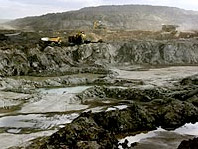A commercial-scale process to extract and reuse pure hydrogen from the hydrogen sulfide that naturally contaminates unrefined oil, including oil sands, is one step closer to reality thanks to a collaboration between the U.S. Department of Energy's Argonne National Laboratory and Kingston Process Metallurgy Inc. (KPM) of Kingston, Ontario.
Argonne and KPM researchers have invented a molten copper reactor, an innovative process technology that is more energy-efficient than existing methods, according to Gregory Krumdick, an engineer in Argonne's Energy Systems Division. Moreover, the pure hydrogen gas stream that it extracts can be used to upgrade and clean crude oil and petroleum products and aid in a number of refining processes, KPM President Boyd Davis said. Krumdick, Davis, Alain Roy, KPM's vice president of operations, and former Argonne researcher John Hryn invented the technology.
In the reactor, hydrogen sulfide gas is first separated from the crude oil stock, using technology already in place. This gas is then bubbled though molten copper, which releases pure hydrogen. The hydrogen is then captured for use as a valued product. As the sulfur reacts with the copper, the copper is gradually turned into copper sulfide.
Argonne is collaborating with KPM, a bench-scale process development firm, under a work-for-others agreement. KPM is supported in part by Natural Resources Canada (NRCan), which has provided $600,000 (Canadian) for the research over the last three years.
In addition to generating pure hydrogen, the process creates another valuable product, concentrated sulfuric acid, which is used widely in the chemical industry and which has become a valued agricultural commodity. The concentrated sulfuric acid is created when copper sulfide is reacted with air to recover the pure copper, releasing a concentrated stream of sulfur dioxide which is then reacted with water. The copper is then reused in the process with negligible losses, Krumdick said.
The reactions between the hydrogen sulfide and copper and the copper sulfide and air release energy that helps to heat the system, enabling the researchers to harvest the products efficiently, Krumdick said. The system operates at a temperature of about 1,200 degrees Celsius.
"Technologies that are in use today, including the widely used Claus process, are more energy- and capital-intensive," Krumdick said. "In addition, they also lose the hydrogen in the process. Instead of capturing the hydrogen from the hydrogen sulfide, the Claus process ends up converting it into water."
The multi-step Claus process was invented more than 100 years ago and is the most widely used method for removing the hydrogen sulfide that is present in crude oil and raw natural gas. The Claus process is also believed to be more limited than the Argonne-KPM process in terms of the other types of impurities it can handle. Costly energy-intensive modules that scrub other contaminants, such as ammonia, methane and carbon dioxide from raw oil and natural gas must be separately attached to Claus processing facilities.
Argonne computer modeling strongly indicated that the Argonne-KPM process would deal with those other impurities, a conclusion that was later experimentally proven. Contaminants such as ammonia and various hydrocarbons are reformed to their elemental constituents, providing an added benefit to the process, Krumdick said.
Argonne and KPM continue to scale up their experimental work to further test the process. "Our goal is to develop a pilot scale reactor," Krumdick said. "If a pilot plant demonstrates that the process is a major improvement over existing technology and we believe it is it will spur the interest of industries that use a process to separate hydrogen sulfide," Davis added.
"Companies will be able to retrofit their facilities with the process technology or construct new plants that incorporate it," Davis added. "In the meantime, we are working with Argonne to use the technology for other energy applications, such as gas cleanup for Integrated Gassification Combined Cycle plants."

